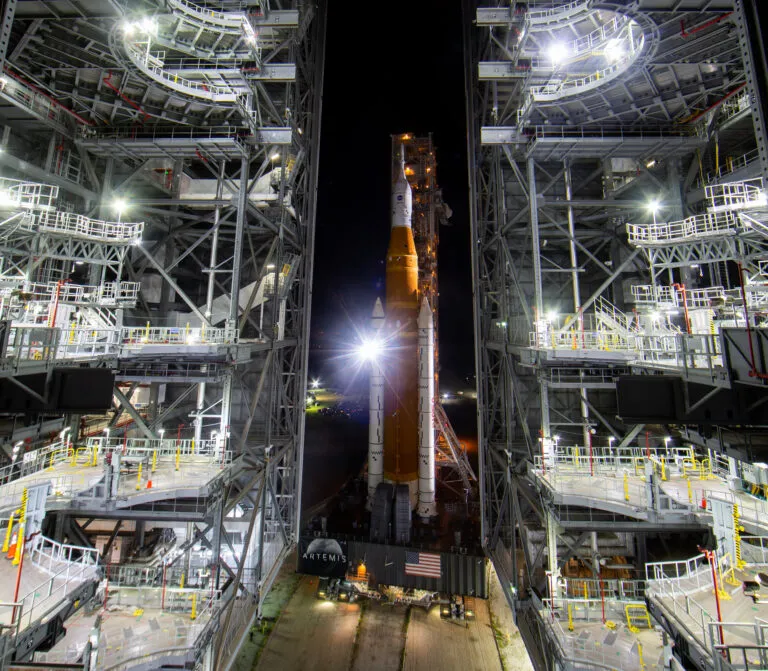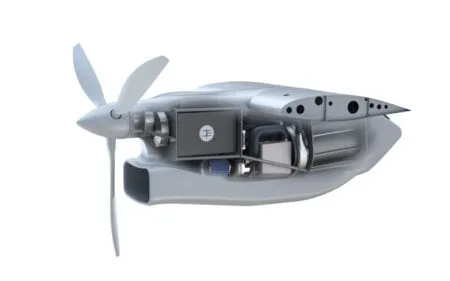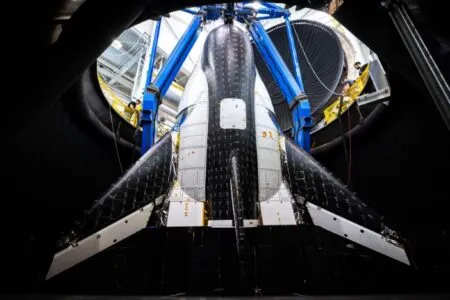Today’s rockets output incredible power to breach Earth’s atmosphere and head towards celestial destinations with precise trajectories. NASA’s Space Launch System is a prime example. Last November almost a million people gathered to watch the moment when the deep space rocket exerted 8.8 million pounds of thrust as it embarked on Artemis I – a 1.4 million-mile mission beyond the moon and back.
While this undoubtedly incredible spectacle took just minutes, many years of work went into ensuring that moment was a success. Space launches present aerospace engineers with extreme challenges. The ability to guarantee the resilience and reliable operation of a spacecraft and its payloads both during and following a launch atop a rocket is fundamental to the industry.
“Spacecraft and their payloads are subjected to very harsh environments during flight and operations, including ground transportation, lift-off, ascent, flight abort, space operations, re-entry, and landing,” explain senior members of NASA’s Loads and Dynamics team, based at the Johnson Space Centre in the USA. “Spacecraft flight hardware must survive and function during and after exposure to these environments to ensure flight safety and mission success.”
Fortunately, key industry stakeholders are well versed in these requirements, priming spacecraft and their payloads for safe and successful missions through highly advanced and rigorous test methods that span several criteria.
“The main purpose of spacecraft and space payload testing is to confirm that they will survive the launch and operational environment,” says Ian Horsfall, dynamics group leader at RAL Space, the UK’s space research and technology development agency.
“These tests are broadly described by the three categories of their environment – mechanical which is vibration, thermal vacuum – heat flow in a hard vacuum, and electromagnetic compatibility and communications.”
Robustness
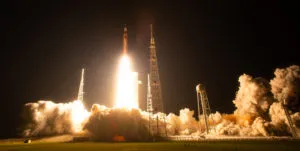
The mechanical element for testing is significant. As missions extend further into the solar system and rockets become larger and more powerful, tests must recreate harsher conditions.
“Vibration testing is an essential part of space flight,” adds the NASA Loads and Dynamics team. “And as we are gearing up to explore the Moon and Mars in the not-too-distant future, we anticipate that the need for vibration testing will only increase to accommodate those missions.”
Critically, it is not just the spacecraft that need to be able to withstand extremes – so too do the payloads and equipment that they carry.
Owing to their high value, satellite vibration qualification tests are closely monitored and carefully conducted. According to Mostapha Choukri, senior business development manager for aerospace and defense testing solutions at Siemens Digital Industries Software, excessive vibration and shock loads can be satellite killers, causing permanent damage to electronics, optics, and other sensitive equipment.
“To compensate for harsh dynamic environments, payloads must be designed and tested to very high dynamic levels,” Choukri says. “Launching into space is extremely noisy so we simulate the acoustic environment during tests and measure how the satellite responds. Large flat panels are most susceptible to damage by acoustic energy because they can undergo large displacements while oscillating at low frequencies.”
Acoustic environment simulation is just one of several vibration tests that are conducted on vital payloads such as satellites to ensure they successfully survive space missions. NASA also uses specialized facilities to conduct static load tests, proof pressure, thermal vacuum, and shock tests, for example.
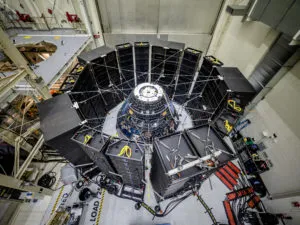
“In the case of high-frequency stochastic environments, susceptible spacecraft flight hardware is subjected to random vibration spectra that are representative of the loads and duration it will experience over its operational lifetime,” the NASA Loads and Dynamics team adds.
Such tests are typically performed using electromagnetic shaker systems – a technique common in the industry, and one that is also highlighted by Professor Guglielmo Aglietti, director of the Surrey Space Centre at the University of Surrey.
“The use of electrodynamic shakers to excite the base of the satellite or other payload to reproduce the vibration environment created by the launch vehicle is typical for dynamic and vibration tests,” he says.
“Further, static tests are also performed using hydraulic systems to apply loads, typically for large structural items, but not for smaller payloads or equipment. It is for larger satellites that we use vibroacoustic tests, putting the test subject in a reverberant chamber.”
The size and type of payloads involved dictate which test methods and environment simulations are used. However, there are a host of other factors also at play.
“The type of launch vehicle being used, payload geometry both in stowed status for launch and deployed status in use, and the type of mission environment all need to be considered carefully,” says Ian Holder, a spacecraft environmental test manager for Airbus.
“These factors help define temperature, pressure and vibration envelopes that will need to be satisfied to ensure payloads are fit to survive launch and their intended mission environments.
“A Martian environment may have extremes from minus 130˚ C to more than 20˚C, for example.”
Innovation
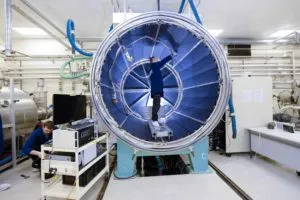
Despite the progress that has been made with testing, failed launches are not uncommon. Of the 186 orbital launches attempted last year, there were seven outright failures and one partial failure, showing clear room for improvement in all aspects of spacecraft and payloads engineering.
Improvements are constantly being explored and are achieved through technical innovation. Choukri says, “The space industry is always looking for ways to protect precious payloads.
“For instance, you have the importance of the fairing to help protect satellites against aerodynamic heating and acoustic vibrations, and an acoustic blanket as a sound-absorbing material to reduce acoustic vibrations caused by engines and the atmosphere.
“In addition, vibration and shock isolation systems of the entire spacecraft are used to reduce vibration loads at launch. And there is a lot that can be done on the launch pad itself. Many sites for launching large rockets are equipped with a sound suppression system to absorb or deflect acoustic energy generated during the launch.”
The NASA Dynamics and Loads team also point to the fact that improved predictions of vibration environments have substantially contributed to optimizing the design of spacecraft and many
spacecraft components.
“High fidelity simulations help reduce uncertainty and provide more realistic load environment estimates earlier in the design process,” the team reveals.
“This can help identify fundamental issues that lead to high loads such as adverse dynamic coupling between spacecraft and components, or if significant component resonances fall with the ranges of the peak random vibration spectra.”
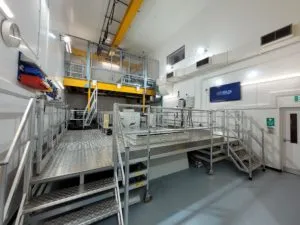
Several leading facilities are driving innovative test methods forward globally, each delivering new and novel techniques. The Johnson Space Center, which includes the Structures Test Laboratory is a prime example. The Laboratory provides a range of vibration tests, including high-g testing, high-capacity testing and high-force testing.
As a result, the Structures Test Laboratory has been used in numerous space programs, including the Space Shuttle, International Space Station, MPCV Orion and the Commercial Crew Program.
The National Satellite Test Facility (NSTF) in the UK is another second example. Unveiled last year, it is a world-class set of co-located facilities operated by RAL Space that has been specifically designed for the environmental testing of space payloads and satellites, including vibration.
“Spacecraft are often immensely valuable, and relatively fragile, so moving them between facilities is discouraged,” Horsfall explains. “For this reason, single test facilities with a complete set of test methods are favored. In some cases, it is cheaper and safer to move the test facility to the spacecraft.”
Forecasts for the future
Moving forward, all the major players in the space sector will continue to push the boundaries of aerospace engineering further to optimize spacecraft and payload vibration testing, with several innovative initiatives already underway.
In the case of Siemens, a major focus is Direct Field Acoustic Noise testing (DFAN) – an alternative test method to the standard acoustic test in reverberation rooms using commercial loudspeakers. Critically, this offers a more economical option and greater flexibility to perform acoustic tests away from scarce and expensive testing facilities. “Another trend is the use of digital twins,” Choukri adds.
“Mechanical qualification testing is risky business because space systems are often unique. In space engineering, there is seldom room for prototyping to ensure qualification testing campaigns are fully under control. However, over-testing a structure above its specifications could lead to early component failures.”
To address this, engineers can de-risk qualification tests by preparing them virtually on a digital twin using software such as Siemens Simcenter.
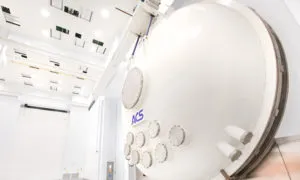
“We can conduct virtual DFAN testing using a digital twin,” Choukri affirms. “With Simcenter 3D, we can de-risk the test and predict the performance of the acoustic field and structural response of the test item.”
Aglietti agrees that there will be a growth in test facilities, as well as improvements in the capability to mathematically model tests before engineers conduct physical tests. “This will help to guide activities and improve the quality of the models, ultimately reducing design margins,” he affirms.
For NASA, much of the future of vibration testing lies in addressing the issues around random vibrations.
“These will continue to be a significant issue unless radical changes occur in the approach to send payloads to space,” the Loads and Dynamics team says. “As such, the arena of random vibration will grow as the scope of space exploration expands.
“Further, the increased use of commercial partners as part of NASA’s plan toward procuring services rather than in-house development is likely to grow demand for NASA to provide testing support services and expertise.”
Equally, Horsfall forecasts a separate set of challenges, namely looking at achieving the complete simulation of the vibration environment in all axes simultaneously – something he describes as the holy grail in vibration testing.
“This has proven extremely difficult to achieve,” he says. “The shock environment and propagation of shocks is a less well-developed field and shock propagation is not as amenable to numerical modeling. Consequently, test failures in vibration are exceptionally rare whilst failures during shock testing, at least at the initial characterization stage, are quite common.”
It is clear that innovation in spacecraft and payload vibration testing will continue to fuel improvements and that these initiatives will serve to support the space industry as it continues to fly towards its new ambitions on the horizon.


